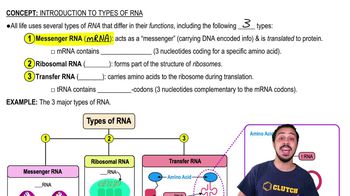Here are the essential concepts you must grasp in order to answer the question correctly.
Transfer RNA (tRNA)
Transfer RNA (tRNA) is a type of RNA molecule that plays a crucial role in protein synthesis. It serves as an adaptor that translates the genetic code from messenger RNA (mRNA) into amino acids, the building blocks of proteins. Each tRNA molecule carries a specific amino acid and has an anticodon region that pairs with the corresponding codon on the mRNA during translation.
Recommended video:
Introduction to Types of RNA
Amino Acid Attachment Site
The amino acid attachment site, often represented as the 'CCA' sequence at the 3' end of the tRNA, is where a specific amino acid is covalently bonded to the tRNA. This site is essential for the tRNA's function, as it ensures that the correct amino acid is delivered to the growing polypeptide chain during protein synthesis, based on the sequence of the mRNA.
Recommended video:
Anticodon
The anticodon is a sequence of three nucleotides on the tRNA that is complementary to a specific codon on the mRNA. This complementary pairing is critical for ensuring that the correct amino acid is incorporated into the protein being synthesized. The interaction between the anticodon and codon is a key step in the translation process, facilitating the accurate reading of the genetic code.

 Verified step by step guidance
Verified step by step guidance Verified video answer for a similar problem:
Verified video answer for a similar problem:


 7:20m
7:20m